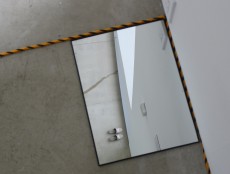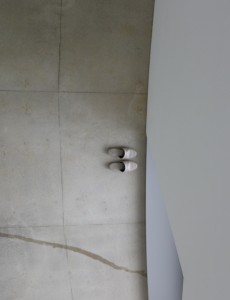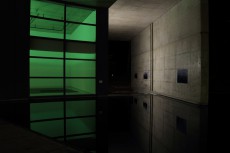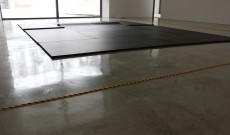
Here and Beyond
10:00am - 6:00pm,October 28 - December 10, 2017 / Admission Free
[wp-blogro11 catname=air2017-5en orderby=ur1]
Clémence CHOQUET & Mickaël GAMIO

Neither here nor there
Offset print photograph, rubber boots, 2017.
photo: YAMAMOTO Tadasu
Small Yet Significant: A Presence in Place
ITO Satoko
Clémence CHOQUET and Mickaël GAMIO’s washitsu (slippery area) features rubber mats placed in the center of the gallery, laid out to resemble a Japanese-style tatami room, which conveys a sense of stability. But the mats partially overlap and undulate, hinting at plate tectonics and the movement of water and calling to mind unsettling images such as earthquakes and floods. A single sheet of glass separates the exhibition space from the Water Terrace. The terrace blends in with the surrounding landscape and seems to confront the images of water and crustal movement in artwork, which evokes the geographical relationship between Japan and the seas that surround it. Choquet and Gamio’s installation, which spanned both the interior and exterior of the ACAC gallery space, was built to be subtle, combining multiple sensations and hinting at the spaces between stability and instability. This allowed the visitors to experience the architectural space and, one by one, discover the relationships between these spaces and the works within them.
Black and yellow tiger rope is glued to the concrete floor [fig.1], forming a wide frame around the rubber mats that stops visitors near the entrance, as if to warn them to keep their distance from a hazardous material. It serves not only to create a border between the exterior and interior, but also to show the installation as a work that incorporates the architecture. You could also say it is a mechanism that reminds visitors to pay attention to the entire space without focusing solely on the artwork in the center.When visitors proceed straight ahead along the rope and look at the space from the opposite side, they notice a green light atop the low protruding ceiling. The light, whose presence is all but hidden in the daytime, was remind viewers of emergency exit signs that we see each day but hardly notice. Exit signs are always on, just in case of emergency. What an inorganic, artificial, and quiet presence. The earth rotates the sun goes down, yet the exit sign cannot change. Its green glow only strengthens in the absence of the sun. The light, which was installed in case of emergency, induce a sense of both security and anxiety while enveloping visitors in a spectacular and quiet cycle of time.
When the sun goes down, artificial lights reflect a mirror image of the architecture on the surface of the Water Terrace and reveal a basement under the water. The sight of a fictional, seemingly bottomless basement, which dances eerily on the water, symbolizes the instability that Choquet and Gamio’s work represents. In the right corner of the gallery near the window is a mirror placed on the floor alongside the rope. It reflects a pair of slippers affixed to the ceiling and appears to flip the room upside down [fig.2][fig.3], imitating the underwater scene from the terrace outside. Along with an unstable feeling of inversion, it also captures the elements of the adjacent pool of water, blurring the boundary between interior and exterior.
Outside the windows, visitors could see a pair of rubber boots facing a photograph of the horizon on the concrete wall of the Water Terrace. They maintain their distance from the boots, which are separated by the water and the window, and are reminded of someone looking at the picture, perhaps even themselves, which seems to invite them outside for a closer look.
A wall in the Water Terrace cuts into the curving arc that forms the gallery, creating a corridor that narrows as it extends inward toward the center of the terrace. The sharp lines of the stepped Water Terrace help to emphasize perspective even further. The photographs transform the outdoor corridor into an exhibition space that entices visitors to have a look at the water’s edge, whose expressions change quietly with the sunlight that shines from behind. The photographs exhibited in this peculiar space were printed on extremely thin material, much like the political campaign posters one often sees in Japan, and were glued directly to the concrete wall. Though the photos showed images of a vast ocean, with a slight change in perspective, they could also vanish, becoming one with the grey wall when their surfaces would become wet with condensation in the morning and evening.
Rubber boots are provided for visitors to walk into the Water Terrace. When visitors don the rubber boots and walk toward the photos, they feel the resistance of the water slowing their movement and hear the sounds of water reverberating off the concrete walls. This shifts their attention to the physical senses, transforming the very act of walking into a sensation. The tranquil, cloudy horizon captured in Neither here nor there reveals an infinitely distant landscape. Though the visitor’s body may face a concrete wall, their consciousness is transported inward to the self and outward to nature. Mind the Gap―千畳敷, 1000 tatami mats size shares the same elements found in Washitsu (slippery area)―water, volcanoes, and tatami. Senjojiki, located in the town of Fukaura in western Aomori, is a marine terrace lifted out of the sea during an earthquake centuries ago. Its sheer vastness is what earned it its name, which can be translated as “the place of 1,000 tatami mats.” Senjojiki is located due west on the other side of the photo, so visitors stare through the actual scenery in the photo in the direction of the coastline that lies beyond. Perhaps the reason why visitors become so immersed in the horizons in these photos and can extend their imagination far past the concrete is because it is an installation based on fact. The installation elicits strong reactions, which only amplify this strange reality where viewers find themselves wearing rubber boots in a pool of water.
Choquet and Gamio’s installation carefully places their research findings within an architectural space rather than an exhibition that takes advantage of the space itself. In doing so, the space itself seems to transform and more strongly suggest the relationship between the space and the objects within it. Though the artworks are spread throughout the gallery interior and exterior, they forge a quiet harmony with one another. As visitors walk through and experiences each piece, they decipher the relationships between them, one work at a time. The artists pick up on seemingly unchanging natural phenomena and trivial things that go unnoticed in everyday life and, by connecting them, serve as go betweens to reflect certain aspects of society. Choquet and Gamio allow their visitors to pick up on strong, sweeping, and unceasing movements that our human senses can barely perceive.
(translate: Queen & Co. )

fig.2
Washitsu (slippery area), detail (rope glued on the floor)

fig.2
Washitsu (slippery area), detail (mirror on the floor)

fig.3
Washitsu (slippery area), detail (a pair of slippers set on the ceiling)

Neither here nor there
Offset print photograph, rubber boots, 2017.
photo: YAMAMOTO Tadasu

Washitsu (slippery area)
Rubber mats, green light panels, rope, mirror, slippers, 2017.
photo: YAMAMOTO Tadasu

Mind the Gap –千畳敷, 1000 tatami mats size
Offset print photographs, rubber boots, 2017.
photo: Mickaël GAMIO

photo: Mickaël GAMIO
この現実のむこうに―Here and Beyond
10月28日(土)-12月10日(日)10:00-18:00 会期中無休/無料
クレマンス・ショケ&ミカエル・ガミオ
Clémence CHOQUET & Mickaël GAMIO

《ここでもなく、そこでもない》
オフセットプリント写真、長靴、2017年
撮影:山本糾
場に宿るわずかな、しかし大きな存在
伊藤聡子
ギャラリーの中央に配置されたゴムマットは、《和室(不安定な場所)》の一部で、その敷き方によって日本の居住スペースである畳と安定感を示しているが、マットを部分的に重ね合わせたり波打たせたりすることで同時に地層のプレートや水の動きを暗示させ、地震や水害といった不安なイメージを与える。地殻変動と水のイメージは、窓外の水のテラスへ連続すると、一面のガラスを挟んで風景の中に溶け込む実際の水と対峙し、海に囲まれた日本の地理的関係を想起させる。異なる複数の感覚を共存させながらも、作品としてそれらの中間地点を提示するクレマンス・ショケ&ミカエル・ガミオのインスタレーションは、ACACのギャラリースペース内外にわたって細やかに設置された。それは、鑑賞者自らが建築空間を体験し、点在する作品と空間との関係性を一つ一つ見つけていくことになる。
コンクリートの地面に接着されつつゴムマットをぐるりと広く囲むトラロープは[fig.1]、入り口付近で鑑賞者を足止めさせ、まるで危険物に近寄らないようにするための注意喚起のようだ。それは内と外の境界をつくるだけではなく、建築を含めて作品として見せるために機能する。空間の中心に配置された作品に安易にとらわれて全体を見失ってしまわないようにする仕掛けとなっている。ロープに沿ってまっすぐ進んで、反対から空間を眺めると、天井の低いスペースの上に緑色の光があることに気がつく。日中は自然光によってほとんど気づかれずに存在を潜めるその光は、日常よく目にする、しかし気に留めることもない誘導灯を思い出させる。誘導灯は非常時に人に建物の出口を指し示す、その時だけのために備えて四六時中自動的に点灯する。なんとも無機質で人工的な、そして静かな存在だ。地球の自転によって日が沈むにつれ、何も変化のしようのない誘導灯は、ちょうどそれに反比例して緑色の光の存在を強めていく。壮大で静かな時間のサイクルの中に鑑賞者を包みながら、非常時を想定して備えられたその光は、この瞬間に安心感と不安感を同時に与える。
日没後の水のテラスでは、人工の光が水面に建物を反転させて映し出し、まるで水底に地下室があるかのように見せる。どこまでも続くような架空の地下室が水の中で不気味に揺れている光景は、彼らの作品が表す不安定さを象徴した。ロープに沿って入り口から右側に進んだ窓際の床に置かれた鏡が、天井に並んだスリッパを映し込むことによって天井と床が逆転したように見せるのは[fig.2][fig.3]、テラスに映ったその光景を示したものだ。反転させる不安定な感覚とともに、すぐ外にある水の要素を取り込むことで内と外の境を揺るがす。
ガラス越しには、水のテラスのコンクリート壁に貼られた水平線の写真と、その前に置かれた長靴を見る。水と一面の窓ガラスで隔てて一定の距離を保ち、空っぽの長靴は、自分または誰かが写真の前に立っている姿を思わせ、鑑賞者を外へと誘導する。
水のテラスにある壁は、ギャラリーから続く弧を切り取ることで中心に向かって奥行きを狭め、テラスの段差のラインがさらに遠近感を強調する。奥から取り込まれる光の状態によって静かに表情を変えるその水辺は、写真が貼られることで展示空間へと変わり、人を呼び込んだ。その特異な空間に展示された写真は、選挙ポスターのように屋外の壁に直接貼るようなとても薄い素材に印刷されており、コンクリート壁にぴったりと接着された。写真というイメージである一方で、壁が朝晩に結露すれば、表面もそれと同じように水に濡れる。角度を変えて見ると反射して灰色の壁に一体となり、姿を消してみせるのだった。
鑑賞用に準備された長靴を履いて水のテラスを歩いていく時に感じるのは、歩みを遅らせる水の抵抗と、コンクリート壁に反響する水の音だ。身体感覚に注意を向けさせ、歩く行為を感覚へと変化させるようだ。《ここでもなく、そこでもない》に撮影された曇天に広がるただ静かな水平線は、どこまでも続く遠景を見せる。身体をコンクリート壁に向けながらも、意識を自然と自己へと向かわせる。《足元にお気をつけください―千畳敷》は、室内作品に続いて再び水と火山、畳といった要素を持ち合わせる。西津軽郡深浦町にある千畳敷は、地震で隆起して形成された海岸段丘で、地名は畳を単位にして表したその広さに由来する。写真に面して向かう真西には、ちょうどその海岸が位置しており、観る者は写真の中の実際の風景がある方角を見つめることとなる。写真の水平線に没入し、目の前のコンクリートを超えて遠くまで想像を伸ばすことができるのは、事実に基づいた設えのせいもあるだろう。そしてその反動は大きく、自身が長靴を履いて水辺で写真を見ているという現実に戻る感覚を一層強めるのである。
彼らのインスタレーションは、空間を活かして作品を展示するというよりも、リサーチで得たものごとを建築空間に綿密に宿らせ、そうすることで空間が変化する様、または空間と物との関係性をより強く示すようであった。建築の内外に点在するそれらは互いを静かに響かせ、鑑賞者は歩いて空間を体験するうちに言葉を一つ一つ紡いでいくように各々の作品を読み解いていく。彼らは一見変化が見えないような自然現象と、日常生活でよく見かけるが何気ない存在を取り上げ、互いをつなぐ中間的存在として社会の一面を映し出してみせる。そして観る者は、人の感覚においてはわずかではありながらも止むことの無い力強く大きな動きに、耳を傾けることができるのだろう。

fig.1
《和室(不安定な場所)》の部分(床に接着されたロープ)

fig.2
《和室(不安定な場所)》の部分(床に置かれた鏡)

fig.3
《和室(不安定な場所)》の部分(天井に設置されたスリッパ)

《ここでもなく、そこでもない》
オフセットプリント写真、長靴、2017年
撮影:山本糾

《和室(不安定な場所)》
ゴムマット、緑色の照明パネル、ロープ、鏡、スリッパ、2017年
撮影:山本糾

《足元にお気をつけください –千畳敷》
オフセットプリント写真、長靴、2017年
撮影:ミカエル・ガミオ

撮影:ミカエル・ガミオ
